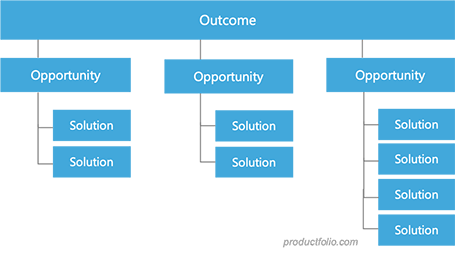What is an Opportunity Solution Tree ?
Opportunity Scoring Tree (OST) is a diagram that aims to help the product discovery process to run smoothly. The visual aid provides clarity on how you intend to go about achieving a desired outcome. It assists product teams in the way they go about solving customers’ problems, helping them to properly think through decisions.
Teresa Torres, who created the framework, describes it as “a simple visual that helps you reach a desired outcome.” The product discovery expert wrote in a 2016 post that she intended it to help product teams overcome the challenge they often have seeing “the big picture.” She suggested the visual aid to bridge gaps in product discovery thinking.

Steps for Build an OST
According to Torres, two dimensions are critical in product discovery: discovering opportunities and discovering solutions. A good grip on this makes the work of product teams easier. The opportunity solution tree is supposed to help with this.
The OST displays what you are learning during the discovery process as well as the decisions you’re making. But how do you put together this visual aid?
Four key steps are identified for building an opportunity solution tree:
- Define the outcome – For product discovery to run smoothly and effectively, it is vital to begin it with a defined outcome in mind. The recommendation is to start with a single goal or metric, even though you might have more than one. You may need to create separate trees for other metrics or identify one that is most critical than others.
- Do user research – You should depend on research when trying to identify opportunities. Do not just start thinking about solutions after determining your desired outcome. Get to know more about the problems and needs of your customers, which inform the opportunities you include in your tree.
- Be flexible about solutions – It is not helpful that solution ideas come from one source, say, the executives. They should emanate from everywhere – more people should be encouraged to provide them. What is most important is that every solution suggested should link to an opportunity.
- Carry out experiments – The final step is to weigh up solutions to fine-tune them. Assess every solution with series of experiments to reduce over-reliance on A/B testing of the overall solution.
You can learn further about this framework in the Product Talk article by Torres.
When Can to Use an Opportunity Solution Tree?
There are several scenarios in which you may find this visual tool useful. It helps you to approach ideation in a well-organized manner.
You can employ the framework when you have many ideas and you’re finding it hard to prioritize them. It is not uncommon to find product teams stuck in such a situation. The steps involved in creating the OST make things less confusing.
For example, it can become clearer what is more important when you have a clear outcome.
However, things might remain somewhat fuzzy even when you have a defined desired outcome. You may not know the best way to proceed. The generative research that is involved in building this tree makes this framework helpful when you have the desired outcome but no strategy to execute. It lets you identify opportunities and know which are more important to pursue.
The OST can help if you find yourself fixated on an opportunity, a solution, and an experiment at any time. If you’re doing excessive multitracking (focusing on too many things at a time), it can help to retrace your steps. The visual aid keeps you from being stuck in the discovery phase.


